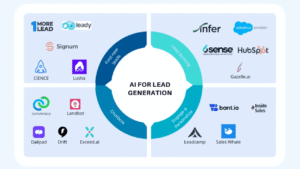Retailers today are standing on shifting and unpredictable grounds. The post-pandemic consumer is digital-first, expects real-time availability, and demands personalized experiences—across both online and physical storefronts. For businesses juggling thousands of SKUs across multiple locations, this spells a logistical and financial nightmare. Overstocks eat into profits, understocks frustrate customers, and inventory guesswork is no longer an option.
Enter SAP’s AI-powered retail solutions—a blend of intelligent analytics, machine learning, and real-time data processing designed to help retailers not just survive but thrive.
Whether you’re running a growing D2C brand or managing a mid-sized chain of stores, SAP AI gives you the tools to move from reactive to strategic—without overhauling your entire operation.
Let’s break down exactly how it works—and how you can start seeing results, one smart move at a time.
-
From Gut Feel to Smarter, Data-Driven Forecasting
Let’s face it—relying on last year’s sales numbers and “gut instinct” isn’t cutting it anymore. Consumer behavior changes by the hour, not the season. That’s where SAP Integrated Business Planning (IBP) turns the tide. Powered by AI and machine learning, it moves retailers—big and small—away from reactive planning and into proactive, precision-driven forecasting.
Instead of looking at historical sales in isolation, SAP IBP connects the dots between multiple demand signals:
- Real-time POS data from both online and offline channels
- Current marketing campaigns
- Regional events and weather patterns
- Social sentiment from platforms like Instagram or TikTok
- External macroeconomic data
Imagine a small apparel brand. With SAP AI, it doesn’t need a dedicated analytics team to know that rising searches for “linen shirts” in Mumbai and a trending reel are signs to ramp up production and distribution—before the shelves go empty or overfilled.
The system continuously learns and adapts, meaning your forecasts become sharper with every cycle. For SMBs, this means no more spreadsheet chaos or fire-fighting stockouts. Instead, it’s about stocking smart, responding fast, and preserving cash flow.
Pro Tip: Don’t try to model your entire inventory in one go. Start with a single product line or region where demand volatility is highest. SAP IBP allows phased rollouts, so you can refine your forecasting muscle as you scale—without disrupting business continuity.
-
Real-Time Inventory Optimization with SAP AI for Retail
Real-time inventory isn’t a luxury anymore—it’s a survival tactic. Whether you’re running 5 stores or 50, the ability to see what’s in stock, what’s moving, and what’s stuck in a warehouse is crucial to cutting costs and keeping customers happy.
SAP S/4HANA and SAP Extended Warehouse Management (EWM) empower businesses with dynamic inventory visibility across locations and channels. That means:
- Auto-replenishment based on real-time store traffic
- Redistribution of slow-moving items before they go stale
- Smart sourcing decisions—if one store runs out, SAP AI reroutes from another store or warehouse to fulfill the order
But here’s where it gets especially exciting for when looking at AI in SMBs: these tools aren’t just for Fortune 500s anymore. SAP now offers cloud-based, modular inventory solutions that don’t require complex infrastructure. Even if you’re operating out of a single warehouse or managing a pop-up store network, you can benefit from real-time data without overhauling your entire system.
Consider a regional grocery chain. SAP AI can flag that organic produce is selling faster in urban locations and redirect restocks accordingly—avoiding spoilage and lost sales. No manual tracking, no last-minute disasters.
Value Insight: Real-time inventory is about more than availability—it’s about agility. When you know what’s happening across your supply chain in real time, you’re equipped to make faster, smarter decisions that reduce waste, prevent lost sales, and respond to demand with confidence. When looking at AI for small businesses, this agility is what levels the playing field.
-
SAP AI-Powered Dynamic Pricing
Once the domain of airlines and eCommerce giants, dynamic pricing is now fully within reach for retailers of all sizes—thanks to SAP’s AI capabilities. Gone are the days of static price tags that stay the same until someone manually changes them. With SAP’s Customer Activity Repository (CAR), pricing becomes intelligent, fluid, and—most importantly—strategic.
By pulling in structured data like inventory levels and sales velocity, and unstructured insights like customer sentiment or online behavior, SAP helps businesses price products in a way that’s:
- Aligned with demand
- Competitive in real time
- Personalized to the buyer’s behavior
Picture this: a mid-sized electronics store sees a spike in demand for gaming laptops during back-to-school season. SAP AI can automatically increase prices slightly—without alienating loyal customers—while offering bundled discounts to entice first-time buyers.
Even for SMBs, these models can be implemented selectively. Start with high-margin or fast-moving SKUs and scale based on impact. During festive rushes or clearance periods, SAP AI ensures you’re not slashing prices blindly—but adjusting them smartly based on inventory turnover, regional demand, and competitor pricing trends.
Takeaway: Dynamic pricing isn’t just about adjusting costs—it’s about creating a responsive pricing engine that works 24/7, aligned with real-world variables. For SMBs, this translates to less dependency on price wars, more margin protection, and pricing strategies that adapt instantly to changing consumer and market behavior. With SAP AI, every price change becomes a calculated move, not a gamble.
-
Hyper-Personalized Shopping Experience That Actually Converts
Personalization has evolved from a “Hi [First Name]” email to being the core driver of retail engagement—and SAP’s AI toolkit helps businesses deliver it at scale and with precision.
With tools like SAP Emarsys and SAP Commerce Cloud, even small and mid-sized retailers can harness the power of real-time customer behavior to create:
- Product recommendations tailored to individual browsing history
- Automated emails triggered by specific actions (cart abandonment, repeat purchases, etc.)
- Dynamic promotions based on past interactions and preferences
This isn’t just about making customers feel special—it’s about increasing conversions, repeat purchases, and average order value. For example, a boutique skincare brand can use SAP AI to identify customers who regularly buy serums but skip SPF, then nudge them with a limited-time SPF offer right after a serum purchase.
And you don’t need massive data teams to do this. SAP’s prebuilt AI models and plug-and-play integrations let SMBs activate personalization without starting from scratch.
Bottom Line: Personalization powered by AI is no longer a differentiator—it’s a performance multiplier. For businesses of all sizes, the ability to deliver contextual, timely, and data-driven customer experiences directly impacts conversion, loyalty, and long-term brand equity. With SAP’s AI tools, retailers can move from reactive marketing to proactive engagement—where every interaction nudges the customer closer to a purchase, and every campaign is grounded in behavioral intelligence.
-
Shrinkage, Returns, and Loss Prevention with SAP AI in Retail
Businesses lose billions annually to shrinkage in retail—a term that covers inventory loss due to theft (both external and internal), damage, fraud, or administrative errors. While these issues have traditionally been treated reactively (often after the damage is done), SAP AI shifts the game from detection to prediction and prevention.
By integrating AI with in-store sensors, surveillance feeds, and POS systems, SAP enables a multilayered approach to fraud and loss management. Computer vision and machine learning work in tandem to:
- Spot suspicious inventory movement patterns (e.g., frequent returns of high-value items)
- Flag anomalies in transaction sequences at checkout
- Identify which SKUs are most prone to returns or misuse—and why
This isn’t just useful for large-scale retailers. SMBs can configure these tools with minimal investment using SAP’s modular deployment options. For instance, a boutique retailer can use SAP AI to trigger alerts if a particular product category shows an unusually high return rate, prompting investigation or policy tweaks.
More importantly, it enables proactive policies: think stricter return rules on frequently-abused items, or flagging high-risk purchases for manual verification without disrupting the wider customer experience.
Takeaway: Shrinkage isn’t just a security issue—it’s a margin killer. With SAP AI, retailers can move from simply reporting losses to preemptively identifying high-risk patterns. This intelligent oversight allows even smaller players to plug revenue leaks early, reduce operational risk, and build a more secure, efficient retail environment without overburdening staff or systems.
-
Sustainability Meets Profitability
Sustainability may have started as a “good-to-have” corporate initiative, but today, it’s firmly tied to consumer expectations, regulatory compliance, and long-term profitability. SAP AI helps retailers bridge the gap between purpose and performance.
By optimizing demand forecasting, streamlining procurement, and reducing overstock, SAP AI naturally cuts down on the two biggest environmental offenders in retail: waste and excess transportation. Fewer unsold goods means less landfill waste and lower emissions from unnecessary freight movement.
Tools like SAP’s Product Footprint Management allow brands to measure the carbon footprint of individual products—from sourcing to shelf—helping them make smarter decisions across the value chain. This is especially valuable for businesses looking to comply with ESG regulations or publish sustainability reports without dedicating entire teams to data mining.
Even SMBs can take the first step by using SAP’s AI-driven insights to:
- Choose lower-impact suppliers
- Optimize delivery routes
- Minimize returns and repackaging waste
Pro Insight:
Too often, sustainability is viewed as a cost center or compliance checkbox—but forward-thinking retailers are treating it as a business enabler. SAP AI allows you to turn sustainability into a strategic advantage by aligning it with operational efficiency. By reducing waste, optimizing transport, and sourcing responsibly, you’re not just cutting emissions—you’re cutting costs.
For small and mid-sized businesses, this is an opportunity to differentiate on values without compromising profit. Consumers are actively choosing brands with transparent, ethical practices. And with SAP’s tools, sustainability efforts become measurable, reportable, and directly tied to long-term growth. In short, it’s not an obligation—it’s an investment that pays off in brand trust, regulatory readiness, and operational resilience.
Integrating SAP AI into Your Retail Ecosystem
So, how do you move from intention to implementation? Integrating SAP AI into your retail operations doesn’t have to be overwhelming—even for small or mid-sized businesses. With a modular, scalable approach, retailers can start seeing impact without waiting for a full digital overhaul.
Here’s a step-by-step roadmap to help you navigate the transition smartly:
Step 1: Identify the Use Case, Not the Tool
Before diving into technology, ask: What’s the problem we’re solving? Is it overstocking? Poor forecasting? Shrinkage?
Starting with a specific challenge helps you map the right SAP solution—whether it’s IBP for forecasting, Emarsys for personalization, or EWM for inventory optimization.
Remember: Clear use cases keep your implementation focused and your teams aligned.
Step 2: Start Small, Think Modular
SAP’s ecosystem is vast—but it doesn’t require a “rip and replace” approach. Begin with a single module or capability. For example, integrate SAP CAR to improve pricing decisions, or test SAP Emarsys with one email campaign segment.
Pro Tip: Choose a pilot category or region. Measure outcomes, iterate, and scale from there.
Step 3: Prioritize Data Readiness Early
SAP AI thrives on clean, consistent, and well-integrated data. If your sales, inventory, and customer data live in silos or are riddled with inconsistencies, the insights will fall short.
Remember: Before implementing any SAP module, assess your current data infrastructure. Consolidate key data sources—like POS, CRM, and inventory management—and ensure accuracy. Even small retailers can start by aligning just two or three core data streams to see meaningful results.
Step 4: Involve Cross-Functional Teams
AI-led transformation doesn’t sit with just IT or ops. SAP AI touches multiple touchpoints—customer experience, logistics, pricing, and finance.
Pro Tip: Include key stakeholders from various functions early in the process. Their input will help tailor the system to actual workflows, not assumptions—leading to better adoption, smoother rollouts, and stronger outcomes across departments.
Step 5: Build for Continuous Optimization
SAP AI isn’t a “set it and forget it” system. It’s designed to learn, adapt, and improve over time—but only if you’re feeding it feedback.
Actionable Tip: Establish regular check-ins to review metrics like forecast accuracy, product returns, or engagement rates. Use these learnings to fine-tune configurations, retrain models, or explore new SAP capabilities as your business evolves.
Choosing the Right Retail AI Partner: How SAP AI Stacks Against Competitors
Once you’ve mapped out your implementation path, the next logical question is: Why SAP? After all, there are several well-known platforms offering AI-powered retail solutions. The key lies in what’s offered holistically—not just AI in isolation, but how deeply it integrates with your operations, data, and long-term growth plans.
The table below offers a side-by-side look at how SAP compares to its closest competitors in the retail AI space.
| Feature/Capability | SAP for Retail AI | Oracle Retail Cloud | Microsoft Dynamics 365 Retail | Salesforce Commerce Cloud |
| ERP Integration | Native, full-suite ERP integration with SAP S/4HANA | Partial integration, mainly financials | Integrated with Dynamics ERP | Requires third-party or custom integrations |
| Supply Chain + Inventory Intelligence | Real-time, AI-driven inventory + warehouse visibility | Available, but limited real-time capabilities | Basic supply chain features | Limited—focuses more on front-end commerce |
| Predictive + Prescriptive AI Models | Offers both predictive and prescriptive AI via SAP IBP | Primarily predictive | Predictive with limited prescriptive AI | Primarily personalization-driven |
| Unified Data Layer | Centralized Customer Activity Repository (CAR) | Data from different modules often siloed | Data unification requires Power Platform | Data unified mostly across marketing & sales |
| Real-Time Capabilities | In-memory computing with SAP HANA for instant decisions | Supports real-time, but not in-memory native | Real-time possible with Power BI layering | Real-time insights mostly in marketing layer |
| AI-Powered Personalization | SAP Emarsys enables behavior-based targeting at scale | Available via Oracle CX Cloud | Limited to Dynamics Marketing + add-ons | Core strength—strong marketing personalization |
| Sustainability & ESG Integration | Product Footprint Management for measurable ESG goals | Basic sustainability reporting | Minimal built-in ESG tools | ESG not core to platform |
| Modular & Scalable for SMBs | Modular cloud solutions designed for phased adoption | Focus on large enterprise | Moderate SMB flexibility | SMB-friendly, but mainly on the marketing side |
In summary, while most platforms offer parts of the AI-retail puzzle—SAP offers the full picture. From demand forecasting and inventory optimization to ESG compliance and customer personalization, SAP brings together data, operations, and AI under one unified system. This makes it especially valuable for retailers seeking long-term agility, not just short-term automation.
Final Thoughts: What Should Be Your Next Steps
As we wrap up, here’s the bottom line: you don’t need to be a retail giant to make SAP AI work for you. Whether you’re managing a chain of 10 stores or just starting out online, the tools and strategies outlined above are designed to scale with your business. Start small—forecast smarter in a single product category, personalize one customer journey, or pilot dynamic pricing in one region.
What matters is momentum. SAP’s modular, AI-driven solutions are designed to scale with your needs—without overwhelming your operations.
At Tech-Transformation, we’re committed to helping retailers turn insights into action. If you’re ready to make your tech stack more intelligent, responsive, and future-ready with SAP AI, get in touch today.









